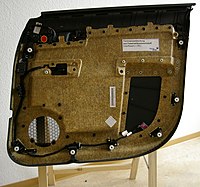
Photo from wikipedia
This work reports the influence of various treatments of pineapple leaf fibers (PALF) reinforced tapioca biopolymer (TBP) on the tensile properties. Three different treatments were selected, such as maleic anhydride… Click to show full abstract
This work reports the influence of various treatments of pineapple leaf fibers (PALF) reinforced tapioca biopolymer (TBP) on the tensile properties. Three different treatments were selected, such as maleic anhydride polypropylene (MAPP) compatibility, maleic anhydride polyethylene (MAPE) compatibility and alkali treatment. Samples with 10% of PALF composition with different concentrations of MAPP and MAPE (1%, 3%, 5% and 7% by weight) and samples with three different treatments were prepared with different PALF compositions (10%, 20%, 30% and 40% by weight). Results revealed that PALF–TBP with 7% of MAPP showed the highest tensile strength and good interfacial adhesion with the matrix as evidenced by the Scanning electron microscopy analysis. Moreover, the chemical analysis by Fourier transforms infrared spectroscopy demonstrated that the MAPP had improved the PALF compatibility and matrix interfaces. Findings suggested that PALF–TBP composites have a great potential to be used for products in engineering applications.
Journal Title: Journal of Polymers and the Environment
Year Published: 2018
Link to full text (if available)
Share on Social Media: Sign Up to like & get
recommendations!